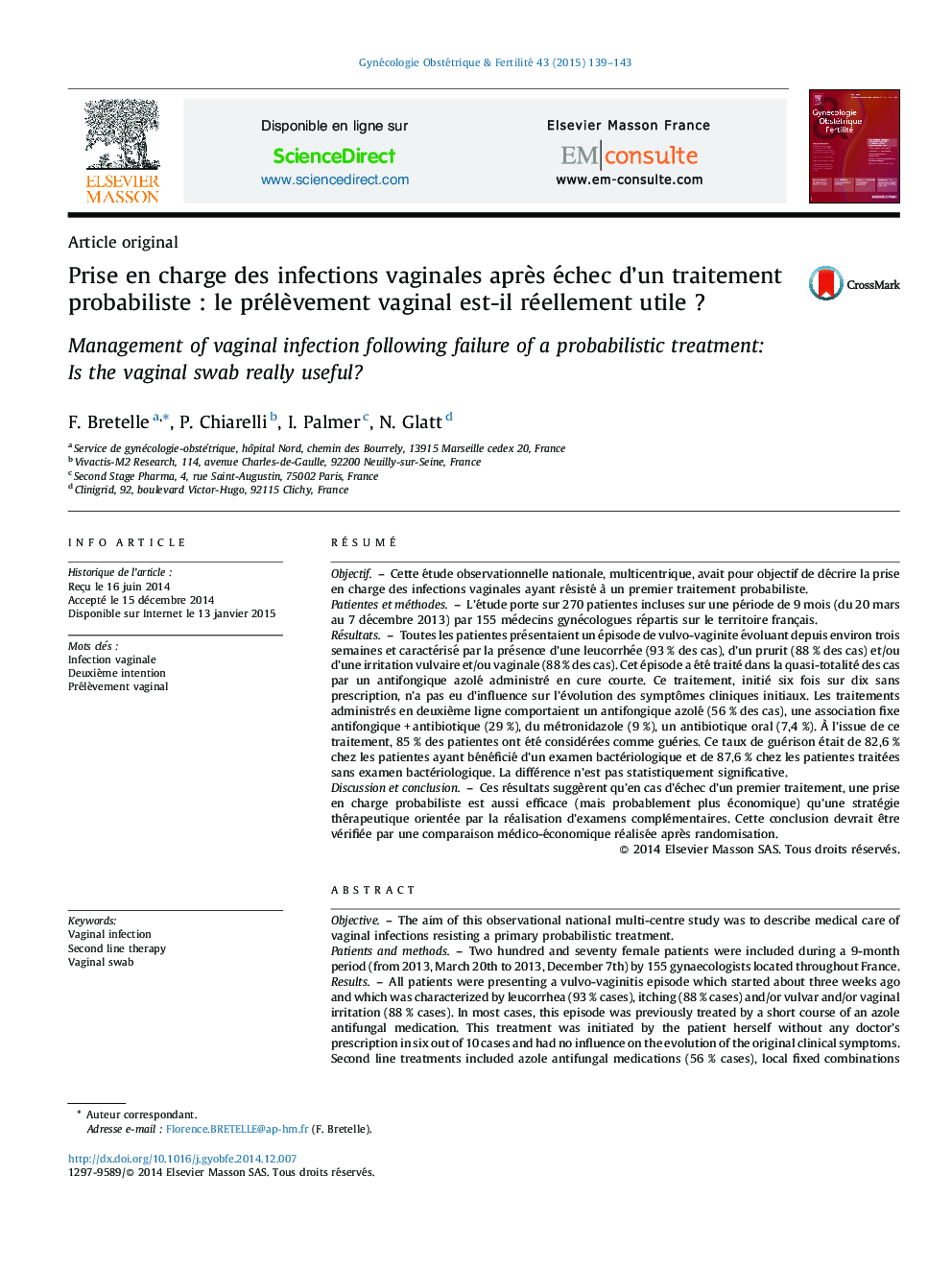| کد مقاله | کد نشریه | سال انتشار | مقاله انگلیسی | نسخه تمام متن |
|---|---|---|---|---|
| 3947953 | 1254496 | 2015 | 5 صفحه PDF | دانلود رایگان |

RésuméObjectifCette étude observationnelle nationale, multicentrique, avait pour objectif de décrire la prise en charge des infections vaginales ayant résisté à un premier traitement probabiliste.Patientes et méthodesL’étude porte sur 270 patientes incluses sur une période de 9 mois (du 20 mars au 7 décembre 2013) par 155 médecins gynécologues répartis sur le territoire français.RésultatsToutes les patientes présentaient un épisode de vulvo-vaginite évoluant depuis environ trois semaines et caractérisé par la présence d’une leucorrhée (93 % des cas), d’un prurit (88 % des cas) et/ou d’une irritation vulvaire et/ou vaginale (88 % des cas). Cet épisode a été traité dans la quasi-totalité des cas par un antifongique azolé administré en cure courte. Ce traitement, initié six fois sur dix sans prescription, n’a pas eu d’influence sur l’évolution des symptômes cliniques initiaux. Les traitements administrés en deuxième ligne comportaient un antifongique azolé (56 % des cas), une association fixe antifongique + antibiotique (29 %), du métronidazole (9 %), un antibiotique oral (7,4 %). À l’issue de ce traitement, 85 % des patientes ont été considérées comme guéries. Ce taux de guérison était de 82,6 % chez les patientes ayant bénéficié d’un examen bactériologique et de 87,6 % chez les patientes traitées sans examen bactériologique. La différence n’est pas statistiquement significative.Discussion et conclusionCes résultats suggèrent qu’en cas d’échec d’un premier traitement, une prise en charge probabiliste est aussi efficace (mais probablement plus économique) qu’une stratégie thérapeutique orientée par la réalisation d’examens complémentaires. Cette conclusion devrait être vérifiée par une comparaison médico-économique réalisée après randomisation.
ObjectiveThe aim of this observational national multi-centre study was to describe medical care of vaginal infections resisting a primary probabilistic treatment.Patients and methodsTwo hundred and seventy female patients were included during a 9-month period (from 2013, March 20th to 2013, December 7th) by 155 gynaecologists located throughout France.ResultsAll patients were presenting a vulvo-vaginitis episode which started about three weeks ago and which was characterized by leucorrhea (93 % cases), itching (88 % cases) and/or vulvar and/or vaginal irritation (88 % cases). In most cases, this episode was previously treated by a short course of an azole antifungal medication. This treatment was initiated by the patient herself without any doctor's prescription in six out of 10 cases and had no influence on the evolution of the original clinical symptoms. Second line treatments included azole antifungal medications (56 % cases), local fixed combinations (antifungal agent and bactericidal antibiotic) (29 %), metronidazole (9 %), oral antibiotics (7.4 %). At the end of the treatment, 85 % patients recovered from vaginitis symptoms. The recovery rate was 82.6 % for patients who got a bacteriological examination and 87.6 % for patients who were treated without any bacteriological examination. The difference is not statistically significant.Discussion and conclusionThese results seem to show that a probabilistic medical care is as effective as (but probably more economical than) a therapeutic strategy guided by the results of further examinations in case of failure of a primary treatment. This conclusion should be confirmed by a medico-economic comparison after randomization.
Journal: Gynécologie Obstétrique & Fertilité - Volume 43, Issue 2, February 2015, Pages 139–143